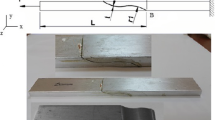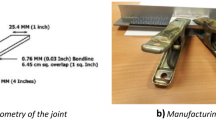Abstract
Adhesion as a joining technology assumes greater significance as attempts are made to join newer materials in increasingly exotic combinations and where conventional joining techniques are either less suitable or quite unsatisfactory. This paper describes work directed at the use of adhesives in the fabrication or repair of structures involving modern structural materials.
This subject is discussed by reference to research involving fibre reinforced polyether ether ketone (PEEK) and particulate silicon carbide reinforced aluminium alloy as representatives of organic and metal matrix composites respectively.
Adhesion is essentially a superficial phenomenon depending as it does upon interactions between the adhesive in its liquid state and the surface of the substrate. The surface preparation of the subject to be bonded is therefore of the greatest importance and this aspect is addressed at length. The success of an adhesive bonding operation is reflected in the strength of the joint generated and in its ability to retain useful joint strength for long periods in the operational environment. These aspects are also considered and in particular the effect of water on the integrity of joints is discussed.
Both plasma and corona discharge treatments were found to be effective in the adhesive bonding of the organic matrix material (PEEK) whilst anodising and the use of coupling agents were both found to be useful in the bonding of the metal matrix composite (MMC).
The versatility of the adhesion process as a joining technology is highlighted by reference to how the individual problems presented by these very different materials are dealt with.
Similar content being viewed by others
References
Shaw, S.J.: Chemistry and Technology of Epoxy Resins, B. Ellis (ed.), Glasgow: Blackie, p. 206, 1993.
Kinloch, A.J.: Adhesion and Adhesives-Science and Technology, London: Chapman and Hall, 1987.
Kinloch, A.J.: Durability of Structural Adhesives, London: Applied Science, 1983.
Packham, D.E.: Handbook of Adhesion, Harlow: Longman, 1992.
Parker, B.M. and Shaw, S.J.: Surface Treatment of Thermoplastic Composites, 1995, DRA Report, DRA/SMC/CR951002.
Young, T.: Trans. Roy. Soc., 95:65,1805.
Sherriff, M.: J. Adhesion, 7:257, 1976.
Fowkes, F.M.: Industrial and Engineering Chemistry, 56:40, 1964.
Author information
Authors and Affiliations
About this article
Cite this article
Bowditch, M.R., Shaw, S.J. Adhesive bonding for high performance materials. Adv Perform Mater 3, 325–342 (1996). https://doi.org/10.1007/BF00136795
Issue Date:
DOI: https://doi.org/10.1007/BF00136795




